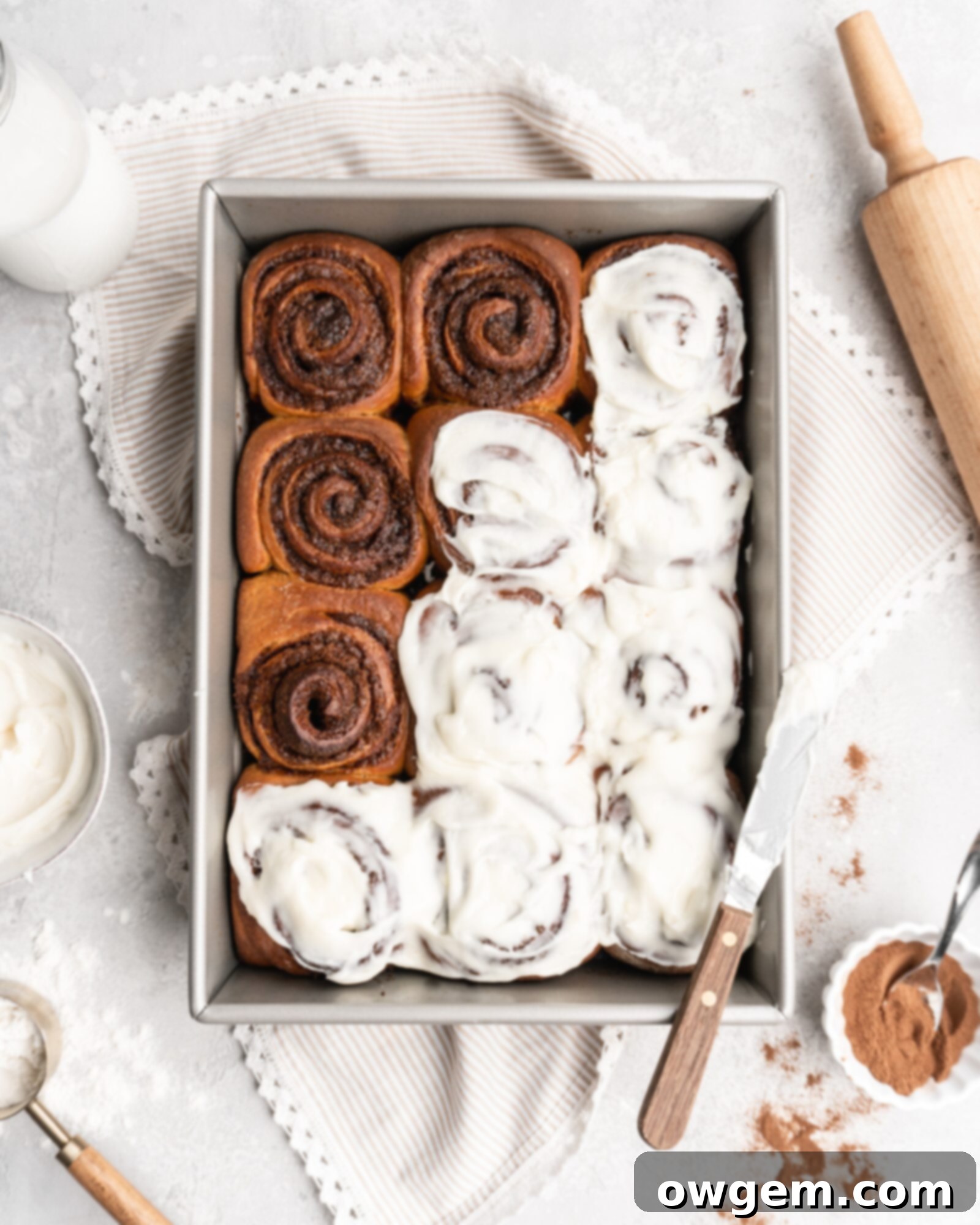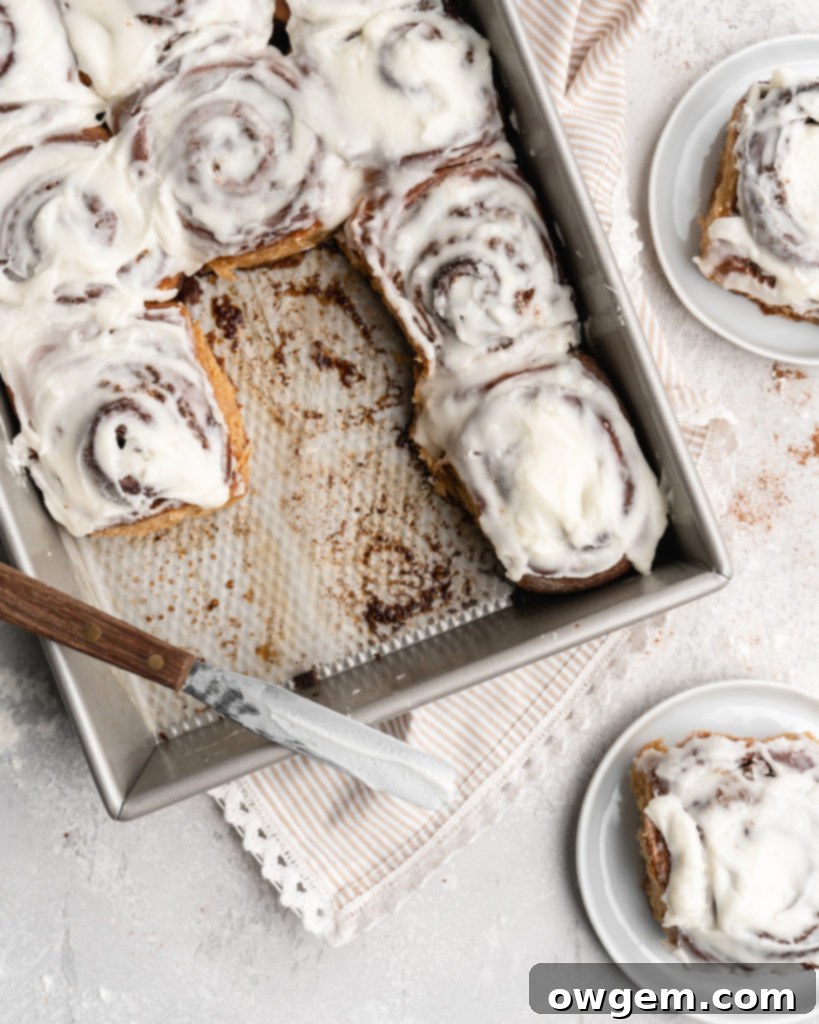Festive & Fluffy: The Ultimate Gingerbread Brioche Rolls with Maple Crème Fraîche Glaze
Step into a world of cozy holiday flavors with these exquisite Gingerbread Brioche Rolls. Imagine soft, pillowy brioche dough, rich with buttery notes and the warming embrace of brown sugar and deep molasses, creating the perfect foundation for that quintessential gingerbread taste. Each roll is generously swirled with a perfectly balanced, sweet, and aromatic cinnamon-ginger filling that sings of festive cheer. To crown these delectable treats, a luscious, silky maple crème fraîche icing cascades over every crevice, adding a bright, tangy counterpoint that elevates the entire experience. These homemade gingerbread cinnamon rolls are not just a breakfast pastry; they’re an edible celebration, ideal for Christmas mornings, holiday brunches, or simply a delightful winter indulgence. Get ready to fill your kitchen with the irresistible aroma of holiday baking and create lasting memories with every bite of these spiced brioche rolls.
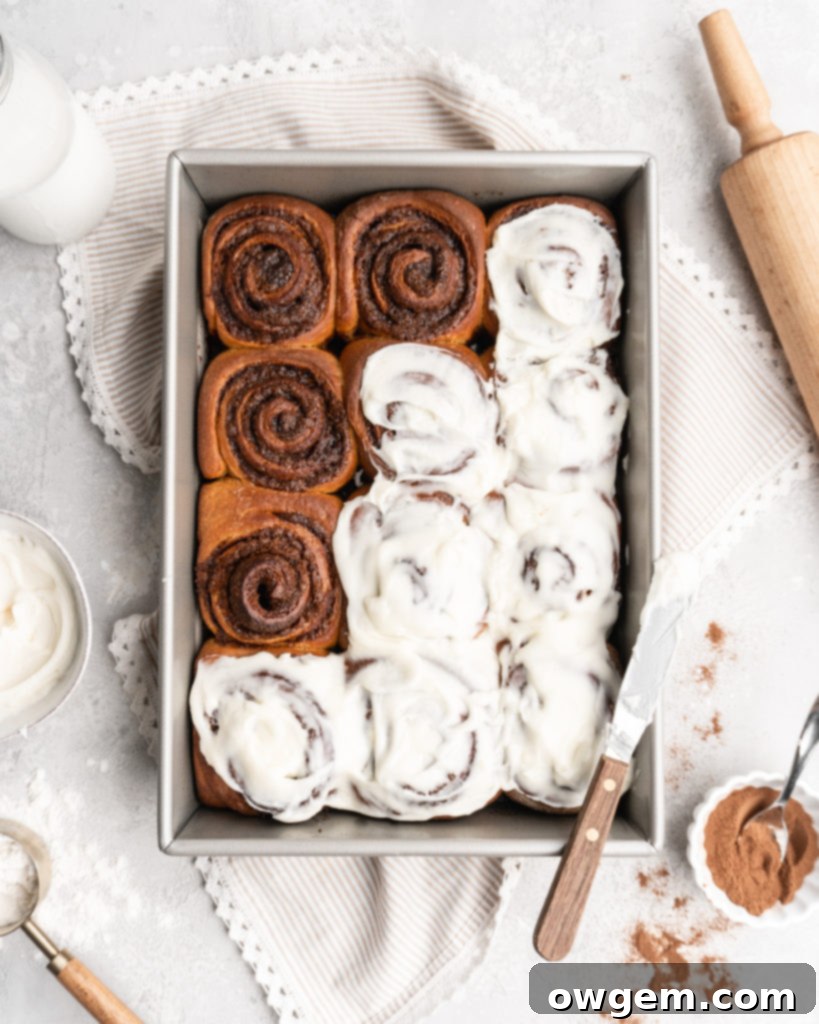
Crafting the Perfect Gingerbread Brioche Dough: A Step-by-Step Guide
Creating a tender, buttery brioche dough might seem intimidating, but with a stand mixer and a few simple techniques, it becomes an incredibly rewarding process. These gingerbread brioche rolls begin with a rich dough infused with classic holiday spices and sweeteners. The stand mixer, equipped with a dough hook, is truly your best friend for achieving that ideal smooth and elastic consistency without excessive manual effort.
How to Make Gingerbread Cinnamon Brioche Dough
The journey to perfect homemade brioche starts with activating your yeast. In a small bowl or measuring cup, gently warm milk to about 105°F (40°C) – it should feel warm to the touch, but not hot. Stir in the active dry yeast and let it bloom for about 5-10 minutes. This crucial step ensures your yeast is alive and ready to make your brioche rolls light and fluffy. You’ll know it’s active when a frothy layer forms on the surface. If it doesn’t foam, your yeast may be old or the milk temperature was off, and you should start again.
Once your yeast is bloomed, pour the mixture into the bowl of your stand mixer. In a separate, larger bowl, whisk together the wet ingredients that give these rolls their distinctive gingerbread flavor: eggs, salt, luscious melted butter, rich molasses, and fragrant brown sugar until thoroughly combined. This mixture provides the sweetness and the deep, caramelized notes characteristic of gingerbread. Add this egg mixture along with the all-purpose flour to the stand mixer. Using a sturdy wooden spoon, mix everything together until a shaggy, uneven dough forms. This initial mixing helps bring all the ingredients together before the intensive kneading begins.
Attach the dough hook to your stand mixer and begin kneading on medium speed. This process should take approximately 5 to 7 minutes. During this time, the dough will transform from shaggy to a smooth, elastic, and slightly tacky consistency. A well-kneaded brioche dough will stick to the bottom of the bowl but pull away cleanly from the sides, indicating proper gluten development. It should be able to pass the “windowpane test,” where a small piece of dough can be stretched thin enough to see light through it without tearing. This elasticity is key to the brioche’s signature tender texture.
After kneading, transfer the soft dough to a lightly greased bowl, turning it once to coat all sides. Cover the bowl snugly with plastic wrap and place it in a warm, draft-free spot to rise. The ideal temperature for proofing is around 70-75°F (21-24°C). Allow it to rise for about an hour, or until it has noticeably doubled in size. This first rise, known as bulk fermentation, develops flavor and airiness in the dough. Once doubled, the dough is ready to be gently deflated, rolled out, filled, and sliced into those irresistible Gingerbread Brioche Rolls. A second, shorter rise will prepare them for baking, ensuring they achieve their ultimate fluffy perfection.
Assembling Your Gingerbread Brioche Rolls: Rolling, Filling, and Slicing Techniques
Once your gingerbread brioche dough has completed its first rise and is beautifully aerated, it’s time for the fun part: shaping and filling! This stage is where you truly transform your soft dough into the delectable rolls you’ve been envisioning. Precision here will lead to uniform, beautifully swirled cinnamon rolls, making the final product as pleasing to the eye as it is to the palate.
How to Roll, Fill, and Cut the Gingerbread Brioche Rolls
Begin by gently turning your risen dough out onto a lightly floured work surface. Using a rolling pin, carefully roll the dough into a large rectangle, approximately 12 inches by 16 inches, aiming for an even thickness of about ¼ inch. Orient the dough so the longer side faces you; this will help when rolling it into a log. The goal is a uniform rectangle to ensure each roll is consistently sized and shaped. Avoid over-flouring your surface, as too much extra flour can make the dough tough.
Next, evenly spread the prepared gingerbread filling over the entire surface of the dough, leaving a narrow 1/2 to 1-inch strip bare along the top long edge. This empty strip is crucial for sealing the roll. Lightly brush a small amount of water onto this bare strip; the water acts as a “glue,” helping the dough stick to itself once rolled. Now, starting from the long edge closest to you, begin to tightly roll the dough away from you into a compact log shape. As you roll, try to maintain consistent pressure and thickness to ensure a uniform spiral in each finished roll. Gently pressing and shaping the log with your hands as you go will help achieve an even diameter from one end to the other.
Once you have a tight, even log, it’s time to slice it into individual rolls. For clean cuts and to prevent squishing your beautiful spirals, a serrated knife is an excellent choice. Alternatively, unflavored dental floss or a thin piece of string can be used for exceptionally neat slices; simply slide it under the log, cross the ends over the top, and pull firmly to cut through the dough. Slice the log into 12 equal-sized rounds, each approximately 1 to 1 ½ inches thick. The uniformity of slices ensures they bake evenly.
Carefully arrange these freshly sliced rolls, cut-side up, into a greased 9×13-inch baking dish or a 12-inch cast iron skillet. Leave a little space between each roll, as they will expand during their second rise and baking. Cover the dish loosely with plastic wrap and return it to a warm place for a second proofing, typically 30-45 minutes. This second rise allows the rolls to become extra light and fluffy, developing that characteristic brioche texture. Once they’ve puffed up and look noticeably larger, they are ready for the oven!
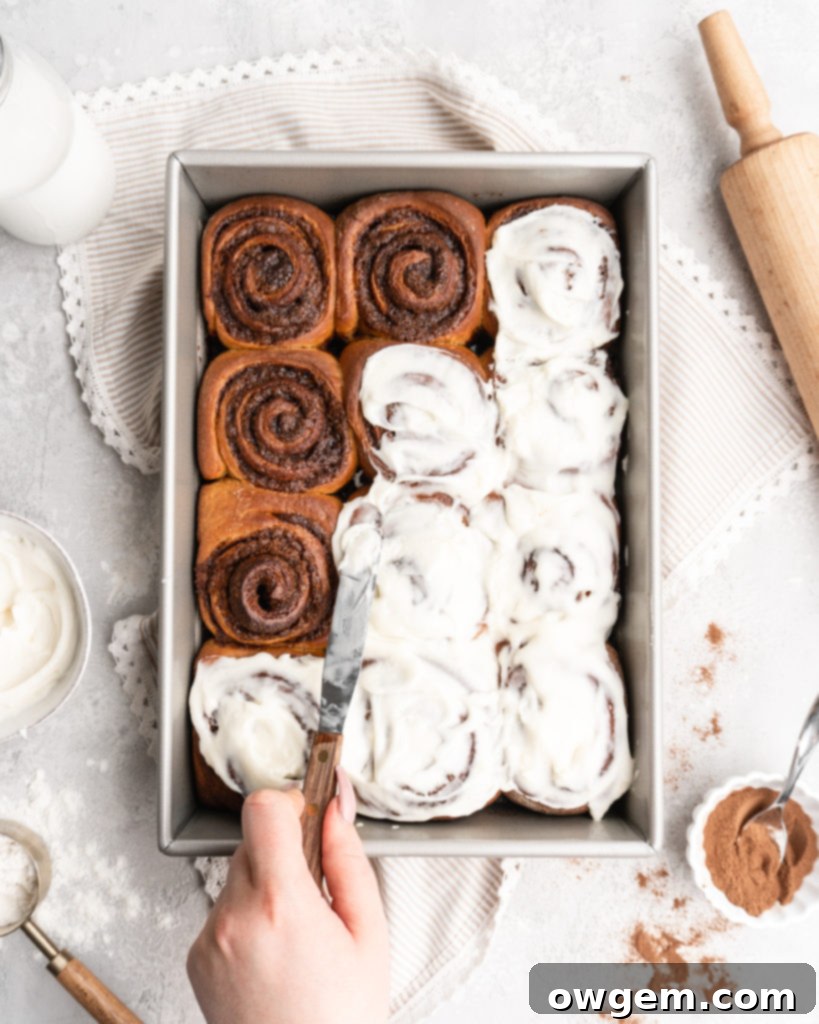
The Secret to a Silky Glaze: Understanding Crème Fraîche
The perfect finishing touch for these delightful gingerbread brioche rolls is a glaze that’s both sweet and subtly tangy, cutting through the richness of the pastry. Our recipe calls for a maple crème fraîche icing, and understanding crème fraîche is key to appreciating its unique contribution to this exquisite glaze.
What is Crème Fraîche?
Crème fraîche is a luxurious, soured dairy product that originates from French cuisine, often considered a more refined and versatile cousin to sour cream. What truly sets it apart is its significantly higher butterfat content, typically around 30-45%, compared to sour cream’s 18-20%. This higher fat percentage makes crème fraîche incredibly rich, creamy, and stable, allowing it to be heated without curdling, which is a common issue with sour cream. In a glaze, this translates to an exceptionally silky and velvety texture that sour cream simply cannot replicate.
While both crème fraîche and sour cream offer a pleasant tartness, crème fraîche’s flavor profile is distinctly less sharp and acidic. It provides a smooth, mild tang that beautifully complements sweet dishes, enhancing their buttery notes rather than overpowering them. Its thicker texture, akin to mascarpone, also makes it an ideal base for glazes and icings, providing body and a luscious mouthfeel without becoming overly runny. This characteristic density ensures the glaze clings beautifully to the warm brioche rolls, melting slightly into their crevices for maximum flavor and visual appeal.
You can typically find crème fraîche in the dairy or specialty cheese section of most larger supermarkets. Its growing popularity means it’s becoming more accessible. However, if crème fraîche is unavailable or if you prefer an alternative, excellent substitutes in this recipe include mascarpone cheese or cream cheese. Mascarpone offers a similar richness and creamy texture, though it is sweeter and lacks the subtle tang. Cream cheese, when softened and beaten smooth, can also provide a thick, tangy glaze, though its flavor is more pronounced and its texture might be slightly different. Regardless of your choice, a smooth, decadent glaze is essential for these gingerbread brioche rolls.
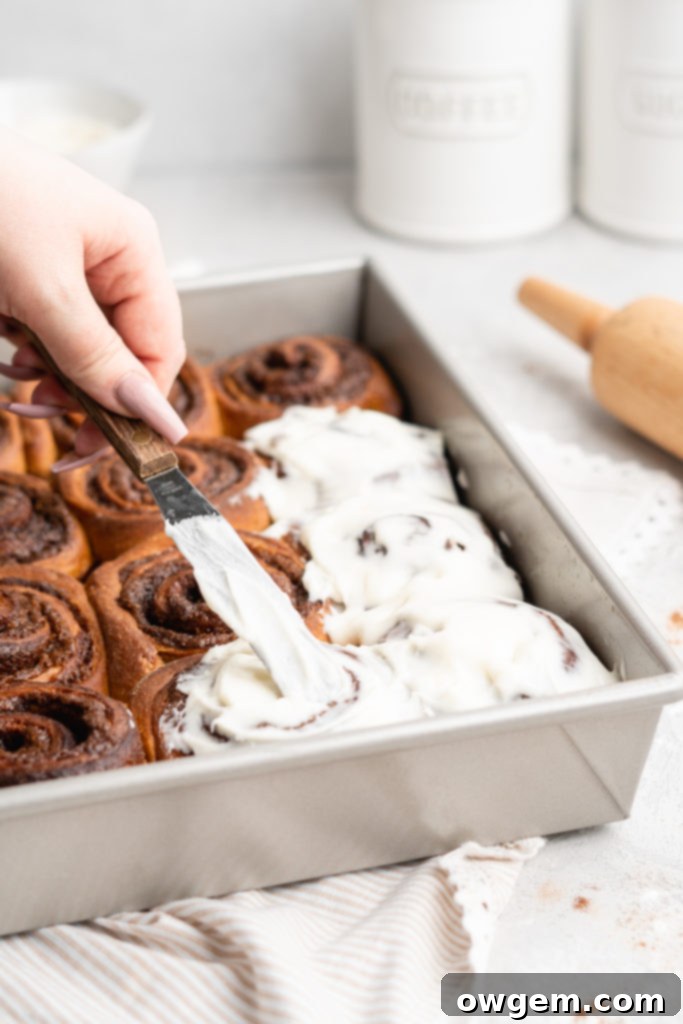
Tips for Perfect Brioche Rolls Every Time
Achieving light, airy brioche rolls with a perfect crumb requires a bit of attention to detail. Here are some essential tips to help you succeed:
- **Room Temperature Ingredients:** Ensure eggs, milk, and butter are at room temperature. This allows them to emulsify better, creating a smoother dough and promoting optimal yeast activity. Cold ingredients can shock the yeast and hinder rising.
- **Don’t Rush the Rise:** Dough rising is a delicate process. Patience is key! If your kitchen is cool, find a warmer spot (like a slightly warmed oven turned off, or near a sunny window) to encourage the dough to double in size within the recommended time. A slow rise can also contribute to deeper flavor.
- **Measure Flour Correctly:** Over-flouring is a common pitfall. Too much flour results in dry, tough rolls. Use a kitchen scale for accuracy (our recipe provides gram measurements!), or use the spoon-and-level method: spoon flour into your measuring cup, then level off with a straight edge without packing it down.
- **Avoid Over-Kneading or Under-Kneading:** The stand mixer is great, but watch for the dough’s texture. It should be smooth, elastic, and pass the windowpane test. Over-kneading can toughen the gluten, while under-kneading won’t develop enough structure for a fluffy texture.
- **Seal the Log Tightly:** When rolling your dough after adding the filling, make sure to roll it tightly and seal the edge well. This prevents the filling from spilling out during baking and ensures a beautiful, compact spiral in each roll.
- **Don’t Overbake:** Brioche rolls are best when just baked through, remaining soft and tender. Overbaking can dry them out. Keep an eye on them and bake until golden brown and an internal temperature of 200°F (93°C) is reached.
Storage and Reheating Your Gingerbread Brioche Rolls
These gingerbread brioche rolls are undeniably best enjoyed fresh from the oven, especially when still warm and glistening with that maple crème fraîche glaze. However, if you find yourself with leftovers (a rare but welcome occurrence!), proper storage ensures they remain delicious for later enjoyment.
- **At Room Temperature:** Store cooled, glazed rolls in an airtight container at room temperature for up to 2-3 days. While still delicious, the brioche will start to firm up after the first day.
- **Refrigeration:** For longer storage, you can refrigerate them in an airtight container for up to 5 days. Be aware that refrigeration can alter the texture, making the brioche a bit denser.
- **Freezing (Baked Rolls):** To freeze baked rolls, let them cool completely. Wrap individual rolls tightly in plastic wrap, then place them in a freezer-safe bag or container for up to 1 month. Thaw at room temperature overnight or reheat directly from frozen.
- **Reheating:** To bring cooled rolls back to life, warm them gently in the microwave for 15-30 seconds, or in a preheated oven (300°F/150°C) for 5-10 minutes until warmed through and softened. If reheating frozen rolls, you might need a longer oven time (15-20 minutes).
- **Freezing (Unbaked Dough):** You can also freeze the unbaked sliced rolls. Place them on a baking sheet and freeze until solid, then transfer to a freezer-safe bag. When ready to bake, place frozen rolls in a greased baking dish, cover, and let them thaw and rise in a warm place for 3-4 hours or overnight in the refrigerator before baking as usual.
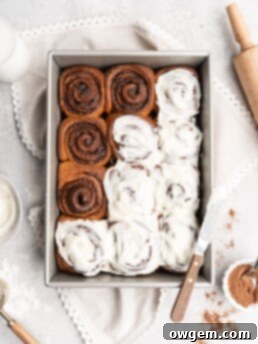
Get the Recipe:
Gingerbread Brioche Rolls
Pin
Rate
Ingredients
Gingerbread Brioche Dough
- 2/3 cup Whole Milk,, warmed to 105°F (40°C)
- 2 ¼ tsp Active Dry Yeast
- 1/4 cup Brown Sugar
- 1 ½ tbsp Molasses
- 1 Large Egg
- 1 Egg Yolk
- 4 tbsp Unsalted Butter,, melted and slightly cooled
- 1 tsp Vanilla Extract
- 1/2 tsp Kosher Salt
- 3 cups (360g) All-Purpose Flour,, plus more if needed, measured correctly †
Gingerbread Filling
- 6 tbsp Unsalted Butter,, at room temperature, softened
- 3/4 cup Dark Brown Sugar
- 2 tbsp Ground Cinnamon
- 2 tsp Ground Ginger
- 1 tsp Allspice
Crème Fraîche Glaze
- 1/2 cup Crème Fraîche
- 1 cup Confectioners Sugar
- 1/2 tsp Vanilla Extract
- 1-2 tbsp Maple Syrup, optional, for extra flavor
Equipment
-
Stand mixer with dough hook
-
9×13 inch baking dish or 12-inch cast iron skillet
-
Rolling pin
-
Serrated knife or dental floss
Instructions
Making the Gingerbread Brioche Dough
-
In a liquid measuring cup, combine the warm milk (about 105°F) and active dry yeast. Stir gently to combine, then allow the mixture to sit undisturbed for about 10 minutes until it becomes foamy. This indicates the yeast is active.
-
To the bowl of a stand mixer fitted with the dough hook, add the brown sugar, molasses, large egg, egg yolk, slightly cooled melted butter, vanilla extract, and the foamy yeast/milk mixture. Whisk these ingredients together briefly to ensure they are well combined.
-
Add the kosher salt and all-purpose flour to the stand mixer bowl. Using a large wooden spoon or spatula, mix the ingredients until a very shaggy, cohesive dough begins to form. Then, attach the dough hook and turn the stand mixer to medium speed. Beat the dough for approximately 5-7 minutes, or until the dough becomes smooth, elastic, and tacky but no longer sticks to the sides of the bowl. It should still stick to the bottom of the bowl.
-
Lightly grease a large bowl. Transfer the kneaded dough to this bowl, turning it once to coat with oil. Cover the bowl tightly with plastic wrap and place it in a warm, draft-free area to rise for about 1 hour, or until the dough has visibly doubled in size.
Making the Gingerbread Filling
-
In a medium bowl, combine all the ‘Gingerbread Filling’ ingredients: softened unsalted butter, dark brown sugar, ground cinnamon, ground ginger, and allspice. Mix thoroughly using a spoon or a hand mixer until the mixture is smooth and evenly combined. If the butter is too firm, microwave in 15-second intervals until spreadable.
Filling, Rolling, & Cutting the Gingerbread Rolls
-
Prepare a 9×13-inch baking pan by lightly coating it with cooking spray and lining it with parchment paper for easy removal. Gently turn the risen dough out onto a lightly floured work surface. Using a rolling pin, roll the dough into a 16×12-inch rectangle, ensuring the longer 16-inch side is facing you. Aim for an even thickness of about ¼ inch.
-
Evenly spread the prepared gingerbread filling over the entire surface of the dough, leaving an empty ½-inch strip along the top long edge. Lightly brush this bare strip with a little bit of water to help seal the dough. Carefully roll the dough away from you, starting from the long edge, into a tight log shape. Try to maintain even thickness throughout the rolling process.
-
Using a sharp serrated knife or unflavored dental floss/string, slice the log into 12 equal-sized pieces, each about 1 to 1 ½ inches thick. Place the rolls, cut-side up, into the prepared baking pan, leaving a small space between them. Lightly cover the pan with plastic wrap and place it in a warm spot to rise for another 30-45 minutes, or until the rolls have visibly puffed up and are nearly touching.
Baking the Gingerbread Rolls
-
Preheat your oven to 350°F (175°C). Once preheated, place the risen rolls into the oven and bake for about 25-30 minutes, or until they are golden brown on top and an internal temperature of 200°F (93°C) is reached. While the rolls are still hot, generously drizzle or spread the prepared Crème Fraîche Glaze over them.
Crème Fraîche Glaze
-
In a medium mixing bowl, add all ingredients for the Crème Fraîche Glaze: crème fraîche, confectioners sugar, vanilla extract, and optional maple syrup. Beat them together using a hand mixer or whisk until the mixture is completely smooth and creamy. Adjust consistency by adding a tiny bit more sugar for thicker glaze or a few drops of milk for thinner.
